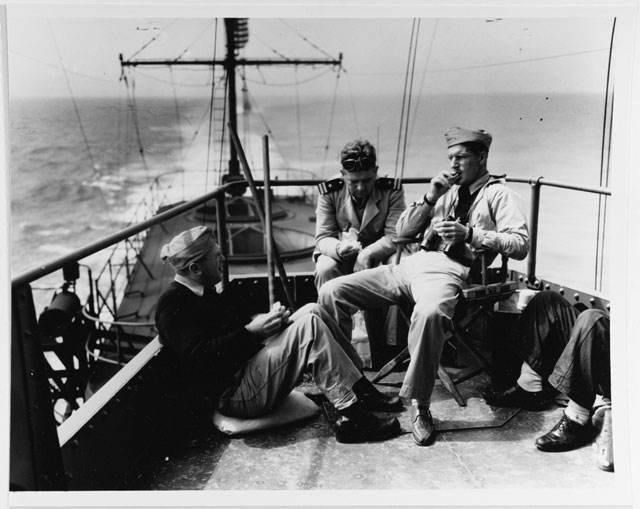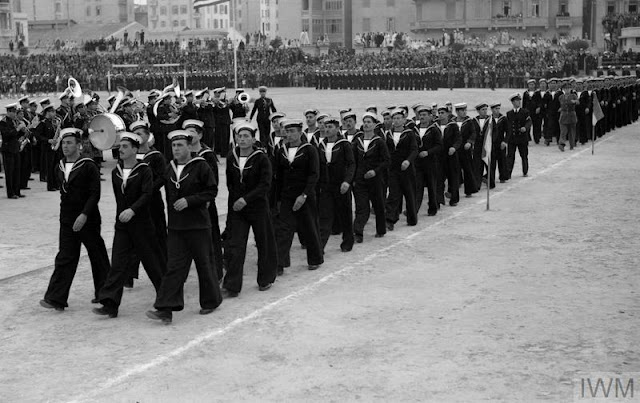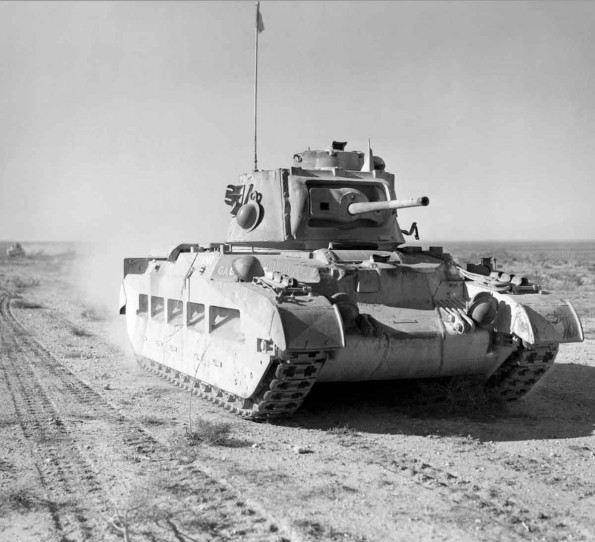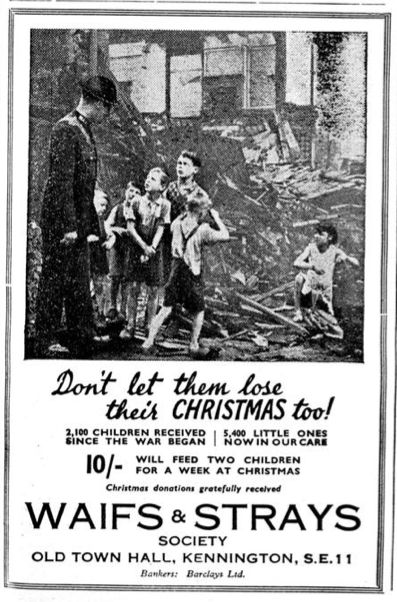Wednesday 25 March 1942
 |
| A US Army soldier hands out copies of Civilian Exclusion Order No. 1 to Bainbridge Island, Washington, residents. All 227 Japanese-Americans on the island are required to vacate the island by the end of the month. The Seattle Daily Times, March 30, 1942, page 2. |
 |
| This photograph was taken 25 March 1942 on the foretop of USS Enterprise (CV-6). The three men (two reporters and an officer, center) are awaiting news of a strike against Marcus Island (US Navy History and Heritage Command). |
- USS Drum sinks a freighter about 120 miles southwest of Japan;
- USS Pompano sinks a tanker about 70 miles northwest of Okinawa;
- USS Tautog sinks a transport about 460 miles southeast of Ulithi.
Japanese submarine HIJMS I-9 launches an E14Y1 reconnaissance "Glen" aircraft to reconnoiter Kiska and Amchitka Islands.
Eastern Front: In the Crimea, Soviet General Kozlov readies his third offensive against the German 11th Army line on the Parpach Narrows for the morning of the 26th. This drive will be aimed at the German strongpoint at Koi-Asan. This will be a much smaller operation than the previous offensives due to the large losses Kozlov's 51st Army has suffered.
German coast batteries sink Soviet patrol boat CKA-121 off Musketeers Bay, Sevastopol.
 |
| Royal Navy ships performing high-speed maneuvers off Fort William, 25 March 1942. © IWM A 9340. |
After dark, RAF Bomber Command launches its first major attack in about two weeks. Things do not go particularly well. The RAF sends 254 aircraft (192 Wellingtons, 26 Stirlings, 20 Manchesters, 9 Hampdens, and 7 Lancasters) in a full-strength attack against Essen. Nine aircraft (5 Manchesters, 3 Wellingtons, and 1 Hampden) are lost. The attack is intended to hit the Essen Krupps works, but savvy German deception efforts lure most of the bombers to a phony site at Rheinburg some 18 miles to the west. Damage is extremely light in Essen itself, and the Germans exactly 1627 propaganda leaflets dropped on the town along with 9 bombs and 700 incendiaries. Only one house is destroyed, with five people killed and 11 injured. The Krupp works are undamaged. One bomber on this mission bombs Airfield Haamstede near the town of Haamstede on the island of Schouwen-Duiveland in the southwest of the Netherlands
In secondary operations, 27 bombers attack St. Nazaire, 38 lay mines off Lorient, and 30 bombers drop leaflets over France. A single bomber hits Lannion airport in Brittany. Two bombers, a Wellington and a Hampden, are lost on these secondary raids. Overall for the night, 11 out of 349 aircraft are lost, a 3.2% loss rate.
The day is notable for a "first" when US Army pilot Major Cecil P. Lessig becomes the first US Army Air Force pilot to fly a mission over France during World War II. He flies a Spitfire with RAF no. 64 Squadron out of Hornchurch, England. Lessig is part of an abortive sweep of 34 fighters that is recalled when 50 Luftwaffe fighters appear on the scene.
Battle of the Atlantic: U-105 (KrvKpt. Heinrich Schuch), on its sixth patrol out of Lorient, torpedoes and sinks 10,389-ton British tanker Narragansett about 400 miles east of Hampton Roads, Virginia. The ship sinks at 06:18, taking all 49 men with it. Schuch had a difficult time with the tanker, missing with two separate salvoes totaling five torpedoes in the early morning hours before finally getting the tanker with two torpedoes.
HMT Sulla, a minesweeper in the service of the Soviet Navy, sinks in the Arctic due to foul weather.
 |
| Some 500 new recruits in the Greek Free Navy marching in Alexandria after being sworn in, Egypt, 25 March 1942. © IWM A 8848. |
British tanker HMS Breconshire, badly damaged during the Second Battle of Sirte, finally is towed into Marsaxlokk Harbour, Malta. The ship carries 5000 tons of oil that are badly needed by the island garrison. The ship has been stranded offshore due to continual Axis air raids ever since the battle. Destroyer HMS Southwold had been protecting her, but it blundered into a British minefield and sank, leaving the tanker defenseless until today.
UK Government: The ruling Tories lose a by-election in Grantham. This is their first loss since September 1939.
US Government: The Department of War forms the White Hosue Communications Agency. This office is intended to create secure communications for the President wherever he is.
Finnish Government: President Risto Ryti writes a letter to Field Marshal Mannerheim at his headquarters at Mikkeli about a proposed offensive toward the Murmansk railway line that the Germans badly want. Ryti notes that "from an operative point of view" the offensive "can be carried out." While Ryti tells Mannerheim to "use your own discretion," he very strongly hints that it would be a better idea to not attack in order to husband Finland's resources. In addition, he mentions the possibility that "the Germans are forced to retreat on the St. Petersburg front," which would "cause us great difficulties and hazards." Among other considerations is the fear that the United States might declare war on Finland due to such an attack. Ultimately, Mannerheim decides to postpone the attack and, in fact, the attack is never made.
 |
| North American Aviation B-25B Mitchell 40-2291 at Eglin Field, Florida, March 1942. (U.S. Air Force). |
US Military: The US Army activates the 77th Infantry Division at Fort Jackson, South Carolina.
Some B-26s of the 22nd Bomber Group (Medium) arrive from the United States at Archerfield Aerodrome, Brisbane. This is part of the standard ferry operation from the States to Australia via the South Pacific.
General Douglas MacArthur visits Lt. General George Brett, the man he replaced in charge of Allied forces in Australia. Brett, who still commands all air units in the Theater, recalls that MacArthur expressed "contempt" for the air units. Brett also recalls MacArthur saying that the Philippines were lost, but not due to anything MacArthur had done. Specifically, Brett recalls MacArthur saying about the air units, "They lack discipline, organization, purposeful intent." MacArthur has a reputation of preferring to deal only with his personal cronies, and Brett is not counted among them.
USS California, a battleship sunk during the 7 December 1941 Pearl Harbor raid, is re-floated today and dry-docked for repairs. Restoring her to service will take until 31 January 1944, after which she earns a total of seven battle stars during the war.
Twenty-two North American Aviation B-25B Mitchell twin-engine medium bombers of the 34th Bombardment Squadron (Medium), 17th Bombardment Group (Medium), U.S. Army Air Force, under the command of Lieutenant Colonel James Harold Doolittle, begin a two-day, low-level, transcontinental flight to the Sacramento Air Depot, McClellan Field, California. These bombers will participate in the Doolittle Raid on Tokyo.
Holocaust: A train carrying 997 young women departs from Poprad railway station in the Slovak Republic bound for Auschwitz. This is the first mass transport by trains of Jews to the extermination camp.
Greece: Greeks defiantly march in the streets of Athens to celebrate National Independence Day. This is very dangerous due to the occupation and the parade is quickly dispersed.
Future History: Aretha Louise Franklin is born in Memphis, Tennessee. After singing gospel in her local church in Detroit, Michigan, Aretha becomes a recording artist at first Columbia Records and then Atlantic Records. She has a string of hits in the 1960s and 1970s, including "Respect," "Think," and "I Say a Little Prayer." Aretha Franklin passes away on 16 August 2018.
March 1942
March 1, 1942: Second Battle of Java Sea
March 2, 1942: Huge Allied Shipping Losses at Java
March 3, 1942: Japan Raids Western Australia
March 4, 1942: Second Raid On Hawaii
March 5, 1942: Japan Takes Batavia
March 6, 1942: Churchill Assaults Free Speech
March 7, 1942: British Defeat in Burma
March 8, 1942: Rangoon Falls to Japan
March 9, 1942: Japanese Conquest of Dutch East Indies
March 10, 1942:US Navy attacks Japanese Landings at Lae
March 11, 1942: Warren Buffett's First Stock Trade
March 12, 1942: Japan Takes Java
March 13, 1942: Soviets Attack In Crimea Again
March 14, 1942: The US Leans Toward Europe
March 15, 1942: Operation Raubtier Begins
March 16, 1942: General MacArthur Gets His Ride
March 17, 1942: MacArthur Arrives in Australia
March 18, 1942: Japan Attacks In Burma
March 19, 1942: Soviets Encircled on the Volkhov
March 20, 1942: "I Shall Return," Says MacArthur
March 21, 1942: Germans Attack Toward Demyansk
March 22, 1942: Second Battle of Sirte
March 23, 1942: Hitler's Insecurity Builds
March 24, 1942: Bataan Bombarded
March 25, 1942: Chinese Under Pressure in Burma
March 26, 1942: Win Or Die, Vows MacArthur
March 27, 1942: The Battle of Suusari
March 28, 1942: The St. Nazaire Commando Raid
March 29, 1942: The Free Republic of Nias
March 30, 1942: Japanese-Americans Off Bainbridge Island
March 31, 1942: Japanese Seize Christmas Island
2020
Some B-26s of the 22nd Bomber Group (Medium) arrive from the United States at Archerfield Aerodrome, Brisbane. This is part of the standard ferry operation from the States to Australia via the South Pacific.
General Douglas MacArthur visits Lt. General George Brett, the man he replaced in charge of Allied forces in Australia. Brett, who still commands all air units in the Theater, recalls that MacArthur expressed "contempt" for the air units. Brett also recalls MacArthur saying that the Philippines were lost, but not due to anything MacArthur had done. Specifically, Brett recalls MacArthur saying about the air units, "They lack discipline, organization, purposeful intent." MacArthur has a reputation of preferring to deal only with his personal cronies, and Brett is not counted among them.
USS California, a battleship sunk during the 7 December 1941 Pearl Harbor raid, is re-floated today and dry-docked for repairs. Restoring her to service will take until 31 January 1944, after which she earns a total of seven battle stars during the war.
Twenty-two North American Aviation B-25B Mitchell twin-engine medium bombers of the 34th Bombardment Squadron (Medium), 17th Bombardment Group (Medium), U.S. Army Air Force, under the command of Lieutenant Colonel James Harold Doolittle, begin a two-day, low-level, transcontinental flight to the Sacramento Air Depot, McClellan Field, California. These bombers will participate in the Doolittle Raid on Tokyo.
Holocaust: A train carrying 997 young women departs from Poprad railway station in the Slovak Republic bound for Auschwitz. This is the first mass transport by trains of Jews to the extermination camp.
 |
| Greeks march in the streets of Athens to celebrate National Independence Day on 25 March 1942. They carry a large Greek flag and sing patriotic songs (National Museum of the US Navy). |
Future History: Aretha Louise Franklin is born in Memphis, Tennessee. After singing gospel in her local church in Detroit, Michigan, Aretha becomes a recording artist at first Columbia Records and then Atlantic Records. She has a string of hits in the 1960s and 1970s, including "Respect," "Think," and "I Say a Little Prayer." Aretha Franklin passes away on 16 August 2018.
 |
| Sailing ships apparently in Boston Harbor, 25 March 1942. Boston Public Library. |
March 1942
March 1, 1942: Second Battle of Java Sea
March 2, 1942: Huge Allied Shipping Losses at Java
March 3, 1942: Japan Raids Western Australia
March 4, 1942: Second Raid On Hawaii
March 5, 1942: Japan Takes Batavia
March 6, 1942: Churchill Assaults Free Speech
March 7, 1942: British Defeat in Burma
March 8, 1942: Rangoon Falls to Japan
March 9, 1942: Japanese Conquest of Dutch East Indies
March 10, 1942:US Navy attacks Japanese Landings at Lae
March 11, 1942: Warren Buffett's First Stock Trade
March 12, 1942: Japan Takes Java
March 13, 1942: Soviets Attack In Crimea Again
March 14, 1942: The US Leans Toward Europe
March 15, 1942: Operation Raubtier Begins
March 16, 1942: General MacArthur Gets His Ride
March 17, 1942: MacArthur Arrives in Australia
March 18, 1942: Japan Attacks In Burma
March 19, 1942: Soviets Encircled on the Volkhov
March 20, 1942: "I Shall Return," Says MacArthur
March 21, 1942: Germans Attack Toward Demyansk
March 22, 1942: Second Battle of Sirte
March 23, 1942: Hitler's Insecurity Builds
March 24, 1942: Bataan Bombarded
March 25, 1942: Chinese Under Pressure in Burma
March 26, 1942: Win Or Die, Vows MacArthur
March 27, 1942: The Battle of Suusari
March 28, 1942: The St. Nazaire Commando Raid
March 29, 1942: The Free Republic of Nias
March 30, 1942: Japanese-Americans Off Bainbridge Island
March 31, 1942: Japanese Seize Christmas Island
2020


















